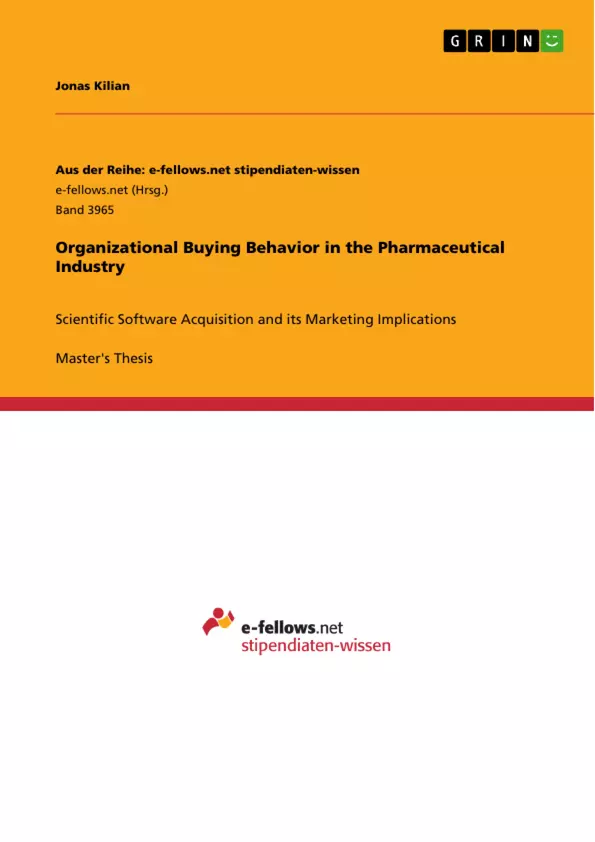How should a scientific software vendor design its marketing activities to effectively boost its sales numbers taking into account the multifacetedness of organizational buying behavior in the pharmaceutical industry?
The rapid technological advent along with the growing need to increase R&D efficiency in the pharmaceutical industry has brought scientific software into focus. For scientific software vendors to successfully tap into that niche market, it is crucial to grasp the complexities of the dynamic decision-making involved in such buying processes. However, the body of organizational buying literature does not address this niche market. Hence, this qualitative interview study aims at providing insights into this process, its participants, and factors driving their decision-making. A thematic analysis reveals that, for investments involving low six-figure sums and below, the buying process generally progresses through six sequential phases eventually resulting in a purchase followed by a single post-purchase phase. What this study highlights is the importance of scientific users, in spite of their hierarchical level, in the decision-making process. The actual buying decision, which is made by consensus, is positively influenced by a set of three deciding factors: product features, soft factors, and economic factors. Based on these findings, scientific software vendors are encouraged to strive for becoming a thought leader by following a science-heavy content marketing strategy.
Inhaltsverzeichnis (Table of Contents)
- Chapter 1: Introduction
- Background
- Research Questions
- Research Objectives
- Thesis Outline
- Chapter 2: Literature Review
- Organizational Buying Behavior
- Factors Affecting The Organizational Buying Process
- Purchase Decision Drivers
- Participants in The Organizational Buying Process – Buying Center
- Decider Typology
- Buying Center-Map
- B2B Marketing Approaches
- Content Marketing
- Thought Leadership
- Chapter 3: Methodology
- Guiding Paradigm and Research Design
- Data Collection
- Sample Selection
- Data Analysis and Interpretation
- Ethical Issues
- Quality Criteria in Qualitative Research
- Validity
- Reliability
- Chapter 4: Findings
- Brand Awareness
- Direct Vendor-Customer Interaction
- Indirect Vendor-Customer Interaction
- Deciding Factors
- Product Features
- Soft Factors
- Economic Factors
- Decision-Making Unit
- Scientific Personnel
- Non-Scientific Personnel
- Buying Process
- Need Identification
- Team Building
- Evaluation
- Decision-Making
- Chapter 5: Discussion & Conclusions
- Discussion
- The Buying Center
- The Buying Process
- Deciding Factors
- Marketing Implications
Zielsetzung und Themenschwerpunkte (Objectives and Key Themes)
This dissertation examines the organizational buying process for scientific software in the pharmaceutical industry, particularly focusing on the acquisition process and its marketing implications for software vendors. The main objective is to provide a comprehensive understanding of how scientific software is acquired within pharmaceutical companies and to identify key factors influencing decision-making. The dissertation delves into the dynamics of the buying center, exploring the roles and motivations of different stakeholders.- The organizational buying process for scientific software in the pharmaceutical industry
- Factors influencing the decision-making process
- The composition and dynamics of the buying center
- Marketing strategies for scientific software vendors
- The role of scientific users in the decision-making process
Zusammenfassung der Kapitel (Chapter Summaries)
- Chapter 1: Introduction provides an overview of the research topic, outlining the background, research questions, objectives, and thesis structure. The chapter emphasizes the growing importance of scientific software in the pharmaceutical industry and the need for a deeper understanding of the purchasing process.
- Chapter 2: Literature Review reviews existing literature on organizational buying behavior, examining key factors affecting the organizational buying process and the participants involved. It discusses various B2B marketing approaches, particularly focusing on content marketing and thought leadership.
- Chapter 3: Methodology details the research methodology employed in this study, including the guiding paradigm, data collection methods, sample selection, data analysis techniques, ethical considerations, and quality criteria for qualitative research.
- Chapter 4: Findings presents the results of the study, analyzing the data collected through interviews. The chapter examines brand awareness, deciding factors, decision-making units, and the buying process in detail.
Schlüsselwörter (Keywords)
The core focus of this research lies within the field of organizational buying behavior, specifically in the context of scientific software acquisition within the pharmaceutical industry. It explores the dynamic interplay between scientific users, purchasing decision-makers, and the influence of factors like product features, economic considerations, and soft factors on the decision-making process. The study also highlights the importance of content marketing and thought leadership as effective marketing strategies for scientific software vendors. Key terms include: organizational buying behavior, scientific software, pharmaceutical industry, buying center, decision-making process, content marketing, and thought leadership.- Quote paper
- Jonas Kilian (Author), 2021, Organizational Buying Behavior in the Pharmaceutical Industry, Munich, GRIN Verlag, https://www.grin.com/document/1131867



